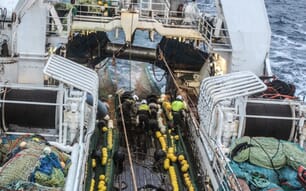Report Highlights:
If adopted, this Council Decision will extend EC animal welfare concerns to a completely
new area of the farming business. Over time, this animal welfare proposal for farmed fish
has the potential of spilling over onto the entire fishin g industry. This development could
eventually impact imports.
The EC has published a proposal for a Council Decision1, which covers animal welfare
aspects of fish farming. The aim is to adopt this proposal at the November meeting of the
Standing Committee of the European Convention for the Protection of Animals kept for
farming purposes. This meeting will be held in Strasbourg in November 2005. If adopted,
this Commission Decision will extend animal welfare regulations to the fish-farming sector.
While the proposal only relates to the EU fish farming industry, there is concern about the
implications these animal welfare requirements could eventually have to imports. Our
office is closely monitoring the developments in this area and encourages the U.S.
aquaculture industry to monitor this new development in EU animal welfare also.
Preamble
The Standing Committee of the European Convention on the Protection of Animals kept for
Farming Purposes.
Having regard to its responsibility under Article 9 of the Convention for the elaboration
and adoption of recommendations to the Parties containing detailed provisions for the
implementation of the principles set out in Chapter I of the Convention based on scientific
knowledge concerning the various species of animals;
Aware also of the established experience in the implementation of the principles of animal
welfare set out in articles 3-7 of the Convention;
Aware that the basic requirements for the welfare, including health of farmed fish consist
of good stockmanship, husbandry methods appropriate to the biological characteristics of
the animals and a suitable environment, so that the conditions under which farmed fish
are kept fulfil their needs.
Concerned with the possibility that the results of developments in breeding and
biotechnology may further influence the welfare of farmed fish and aware of the need to
ensure that such developments do not adversely affect their welfare, including health;
Bearing in mind that it is an obligation of the Committee to consider any recommendation
when relevant new knowledge is available and therefore wishing to encourage the
continuation of research by all Parties with the object of making optimum use of new
techniques to ensure that the needs of farmed fish are met and hence that their welfare,
including health are good;
Considering that in the light of established experience and scientific knowledge about the
biological needs of fish, methods of husbandry and slaughter at present in commercial use
may fail to meet all their needs and hence result in poor welfare;
Bearing in mind that the environment and management have to fulfil the animals
biological needs;
Considering therefore that strong and continuous efforts have to be made to adapt
existing systems and methods and to develop new husbandry systems and methods in
line with the Convention so that the needs of the animals can be met;
Aware that scientific knowledge and practical experience indicate that the provision of a
Recommendation concerning farmed fish is necessary;
Has adopted the following Recommendation concerning farmed fish.
Biological Characteristics of Fish
General biological characteristics of fish
When considering husbandry practices the following general biological characteristics of fish should be borne in mind:
With a few exceptions, such as tuna, fish are cold blood animals (poikilotherms) and, as a result, their metabolic processes are dependent on the environmental temperature;
Fish obtain the oxygen which they need from water via their gills and for some species via their skin. The heart and circulatory system are adapted to this means of respiration;
The basic structure and function of muscles, liver, hormonal control mechanisms and nervous system are similar to higher vertebrates;
The skin of the fish is the first line of defence against disease and provides protection from the environment. It contains sensory receptors for touch, pressure and pain and also has respiratory, excretory and osmoregulatory functions. Within the skin are pigment cells and, sometimes light emitting structures that provide for concealing, advertising or sexual behaviours. The skin also contains mucus glands, which secrete a protective layer over the skin, scales and occasionally poison secreting or electric organs;
Most fish species show maximal emergency responses under stressful conditions, such as :
when they are subjected to low oxygen tension in the water or the presence of certain noxious substances in the water or attacked,
when they are removed from water. However, in the same situations, certain species will show little behavioural reaction even though physiological stress response will be substantial.
Long lasting stressful events, poor water and feed quality, and behavioural problems, may result in immunosuppression and disturbance of reproduction and growth.
Fish respond to the environment and such characteristics are valuable in preserving life and maximising the biological fitness of individuals.
Further Information
To read the full report please click here
Source: USDA Foreign Agricultural Service - September 2005




